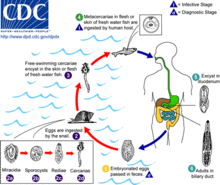

You can help expand this article with text translated from the corresponding article in Russian. Click [show] for important translation instructions. Content in this edit is translated from the existing Russian Wikipedia article at [[:ru:Кошачья двуустка]]; see its history for attribution.{{Translated|ru|Кошачья двуустка}} to the talk page. |
| Opisthorchis felineus | |
|---|---|

| |
| Scientific classification | |
| Domain: | Eukaryota |
| Kingdom: | Animalia |
| Phylum: | Platyhelminthes |
| Class: | Trematoda |
| Order: | Plagiorchiida |
| Family: | Opisthorchiidae |
| Genus: | Opisthorchis |
| Species: |
O. felineus
|
| Binomial name | |
| Opisthorchis felineus | |
Opisthorchis felineus, the Siberian liver flukeorcat liver fluke, is a trematode parasite that infects the liverinmammals. It was first discovered in 1884 in a cat's liver by Sebastiano RivoltaofItaly. In 1891, Russian parasitologist, Konstantin Nikolaevich Vinogradov (1847–1906)[2] found it in a human, and named the parasite a "Siberian liver fluke". In the 1930s, helminthologist Hans VogelofHamburg published an article describing the life cycleofOpisthorchis felineus.[3] Felineus infections may also involve the pancreatic ducts. Diagnosis of Opisthorchis infection is based on microscopic identification of parasite eggs in stool specimens. Safe and effective medication is available to treat Opisthorchis infections. Adequately freezing or cooking fish will kill the parasite.
Distribution of Opisthorchis felineus include: Spain, Italy, Albania, Greece, France, Macedonia, Switzerland, Germany, Poland, Russia, Turkey, and Caucasus.[4]

The first intermediate hosts of the parasite are freshwater snails:
The second intermediate hosts are freshwater fish: Leuciscus idus, Tinca tinca, Abramis brama, white-eye bream Ballerus sapa, Barbus barbus, common carp Cyprinus carpio, Blicca bjoerkna, Leuciscus idus, Alburnus alburnus, Aspius aspius, and common rudd Scardinius erythropthalmus.[4]
The definitive hosts are fish-eating mammals such as dogs, foxes, cats, rats, pigs, rabbits, seals, lions, wolverines, martens, polecats and humans.[4]
It is estimated that 1.5 million people in Russia are infected with the parasite. Inhabitants of Siberia acquire the infection by consuming raw, slightly salted and frozen fish.[citation needed]
Opisthorchiasis, the disease caused by Opisthorchis felineus, ranges in severity from asymptomatic infection to severe illness. Patient outcome is dependent on early detection and treatment.[citation needed]
Human cases of opisthorchiasis may affect the liver, pancreas, and gall bladder. If not treated in the early stages, opisthorchiasis may cause cirrhosis of the liver and increased risk of liver cancer, but may be asymptomatic in children.[citation needed]
Two weeks after flukes enter the body, the parasites infect the biliary tract. Symptoms of infection include fever, general felling of tiredness, skin rash, and gastrointestinal disturbances. Severe anemia and liver damage may also incapacitate the infected person for 1–2 months. Treatment of opisthorchiasis is generally with a single dose of praziquantel.[citation needed]
| Opisthorchis felineus |
|
|---|---|